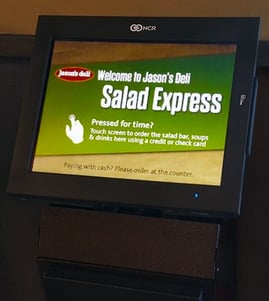Kiosks deliver dynamic content and streamline the ordering process.
Everyone has seen a kiosk in a Quick Service Restaurant (QSR) or Fast Causal Restaurant which boasts “Skip the Line – Order Here.” Digital signage kiosks are popping up all over the country and at a rapid pace. If the project is carefully examined during the planning process, self-ordering kiosks can be beneficial to all parties involved.
The following 4 items are significant pieces for designing a successful kiosk project.
Budget
Proper financial planning is a major step in spearheading a successful digital signage project. A kiosk, combined with an interactive touchscreen, will always be more expensive than traditional signage. As more restaurants make the switch to ordering kiosks, the prices and availability of interactive touch screens are becoming less expensive to deploy. However, it is advantageous to develop a prototype to pilot at a flagship store. After a brief period, you will be able to determine the effectiveness of the digital system and evaluate if a roll-out should be the next step. This will allow restaurants to devise a well-planned budget to carry out the project.
Support A support system for the digital signage network is significant to the overall success of the project. Find a trusted firm to manage the process for the restaurant. These skilled companies have, most likely, installed systems across the country and will be able to create something that will work around the clock with very little interruptions to the system. Most software providers will offer varying levels of a Service Level Agreement (SLAs), which is a “contract between a service provider (either internal or external) and the end user that defines the level of service expected from the service provider.” Be sure to take advantage of the valuable training that is available from the software provider. Some problems are unable to be fixed remotely, so it is imperative that the operator can solve the problem swiftly and proficiently. A restaurant should understand how to complete simple tasks like changing the receipt paper or rebooting the system. After all, the kiosk is rendered useless if customers cannot use it at the point of order.
A support system for the digital signage network is significant to the overall success of the project. Find a trusted firm to manage the process for the restaurant. These skilled companies have, most likely, installed systems across the country and will be able to create something that will work around the clock with very little interruptions to the system. Most software providers will offer varying levels of a Service Level Agreement (SLAs), which is a “contract between a service provider (either internal or external) and the end user that defines the level of service expected from the service provider.” Be sure to take advantage of the valuable training that is available from the software provider. Some problems are unable to be fixed remotely, so it is imperative that the operator can solve the problem swiftly and proficiently. A restaurant should understand how to complete simple tasks like changing the receipt paper or rebooting the system. After all, the kiosk is rendered useless if customers cannot use it at the point of order.
Benefits
A lack of understanding about the benefits can put restaurants at a big disadvantage. Be sure to work with the software developer to familiarize yourself with the available features of the system. Restaurants are moving toward digital signage kiosks, because they provide a fast and smart interface for users and simplify customer transactions. The interactive feature of a kiosk makes people feel connected with the restaurant and they can choose an ordering path depending on their needs. Another big advantage to restaurant owners is the unlimited access to customer analytics. Restaurants can examine consumer behaviors to determine if various calls-to-actions are met during the transaction. For example, a restaurant’s call-to-action could be to upgrade a combo meal to a larger size, add a seasonal coffee, or a dessert item. The system can measure the specific path that the consumer traveled down and how long it took to complete the call-to-action.
Goals
Before a self-ordering kiosk is introduced to customers, a restaurant should clearly define the goals of the new system. Some popular goals may include reducing labor costs, improving the guest’s experience, or processing orders more quickly. The restaurant’s goals will dictate the technology and design that is required for the project to become a success. Be sure that a plan is in place to manage each goal. For example, if the goal is to move customers through the order process quicker, ensure that the kitchen is equipped with enough staff to deliver food in a timely manner. If the kitchen is not properly prepared for the change, it may cause the customer wait time to be even longer than before the kiosk was installed.
Interactive, digital signage kiosk solutions enhance a restaurant’s brand and personalize the consumer’s experience while dining at the store. Kiosks deliver dynamic content and streamline the ordering process. From marketing to consumers, everyone can benefit from installing a self-ordering kiosk. Kiosks also free up employees to perform other tasks that may be lacking during busy meal times, like adding more napkins or cleaning the ice cream machine. Kiosks truly are a win-win for everyone involved in the process!
For More Information:
-- 4 Trends for QSRs Adding Self-Checkout Kiosks
-- 3 Reasons Retailers are Using Instant Credit Kiosks
Still Have Questions? LET US KNOW HOW WE CAN BEST ASSIST YOU! CONTACT AN 'ITSENCLOSURES EXPERT' AT 1-800-423-9911 -OR- SEND US AN EMAIL: INFO@ITSENCLOSURES.COM



